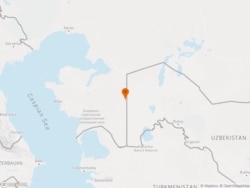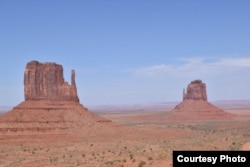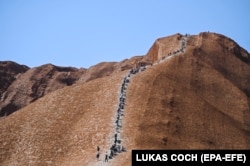
The world's deserts offer many scenic attractions to those hardy souls who dare to venture into such remote regions, with the most spectacular sights often being rock formations that tower above the sand and scrub.
People through the centuries have ascribed religious significance to many of these rocks, and they were invaluable route markers for those traveling through the deserts.
The southwestern United States is known for such rock formations as seen in movies about the American West that use places like Monument Valley in Arizona and Utah as backdrops for their films.
The famed Uluru in the middle of Australia’s Northern Territory is another example.
In Kazakhstan, there is a relatively unknown place called Bozzhira Canyon in western Mangystau Province.
The land around Bozzhira Canyon is generally flat, chalky-white ground that was once -- more than 65 million years ago -- the bottom of the Tethys Ocean. When the ocean receded, it left behind some spectacular rock formations that are now the center of a debate on whether to develop tourism there.
Western Kazakhstan is a desolate area known mainly for its oil and natural gas fields. Most of the money from exports of that oil and natural gas ends up in the big cities of eastern Kazakhstan -- Astana and Nur-Sultan -- while the sparsely inhabited western part of Kazakhstan remains poor.
But the government has recently been working to build up areas in western Kazakhstan along the country’s Caspian coast.
Aqtau is the best such example.
That city's beach is being developed, new hotels are being built, and seaside restaurants line the shore just below a newly built boardwalk. Exclusive neighborhoods with luxurious beachfront homes now dot Aqtau's coastline.
But a few miles inland there is nothing but wide-open territory that stretches as far as the eye can see, with no manmade objects to break up the rugged landscape.
And some 300 kilometers from Aqtau is where the Bozzhira Canyon is located.
For several years, it has been possible to travel from Aqtau to Bozzhira.
Off-road tourist agencies offer such trips, and some include the option of spending the night in tents, a sensible choice for those with the time, since the round trip from Aqtau to Bozzhira takes about eight hours.
But a Turkish company is in talks with Kazakh officials to build a luxury hotel at the base of one of the main rock formations in Bozzhira.
The Rixos hotel chain is seeking Kazakh investors and official permission to build the Bozzhira Safari-Hotel at an estimated cost of some $100 million.
Rixos has already built hotels in Nur-Sultan, Almaty, Shymkent, Turkestan, and at the Borovoi resort area, and recently completed the five-star Rixos Water World Hotel in Aqtau.
The concept design graphics for the hotel in Bozzhira are impressive, yet at the same time give a sense of what this structure would mean in an area people often travel to specifically because of its isolation:
RFE/RL’s Kazakh Service, known locally as Azattyq, spoke with people in Kazakhstan about the idea of a luxury hotel in Bozzhira.
Ruslan Churov was born and raised in Mangystau Province and currently runs a tourist agency in Aqtau that takes people to Bozzhira. Churov is against building a hotel there.
“The construction of a hotel means construction of roads and infrastructure that will have a negative effect on the natural setting,” he said. “Not only on the landscape and the uniqueness of the place, but it will also inflict irreparable harm on the flora and fauna…and block the paths [for animals to go] to the salt marshes and water.”
Churov said his clients go to Bozzhira because they want to “look at the pristine beauty of the place, where there is no trace of human activity.”
Ecologist Orynbasar Tokzhanov warned that the fauna is already in danger at Bozzhira and that the number of saiga antelope has dropped since 1998 by more than 90 percent and gazelle by an even greater percentage, mainly due to disease.
“Construction will drive away the other animals,” Tokzhanov said.
Archaeologists have also pointed out that Bozzhira is a treasure trove for artifacts, from the petrified shells of mollusks to traces of the people who lived or passed through the area over the course of thousands of years.
Sergei Sklyarenko, director of the Center for Applied Biology at the Association for the Preservation of Biodiversity of Kazakhstan, said Bozzhira should be on the UN’s list of cultural heritage sites. He pointed out that Bozzhira is especially unique for Kazakhstan.
“In Kazakhstan, we have either cultural or natural [heritage sites]. We do not have any that are mixed,” he explained.
But oil and gas exploration has held up formal recognition of Bozzhira as a national park or for being forwarded as a candidate for the UN's list of sites of special cultural heritage.
Sklyarenko was not against developing tourism in the area. He said the government should establish a visitors center for people coming not only to Bozzhira but to the many other interesting sites in the Ustyurt Plateau where Bozzhira is located.
But he said hotels would be better located “not far from the Beket-Aqtau highway, at a distance of some 20 kilometers from the Bozzhira Canyon.”
The example of Australia's Uluru -- also known as Ayers Rock -- is instructive here.
For centuries, it held a special meaning to the people of the area, and it was not until the 1870s that the first Europeans came to the area.
The first tourists arrived in the 1930s, and by the 1950s tourism was well-developed in areas around Uluru. Hotels were built close to the rock and, later, holes were bored into it and steel posts put up to hold guide ropes and chains that helped tourists climb the 348-meter formation.
The damage being done to the local environment was clear by the 1970s. The hotels and other facilities catering to tourists were ordered to be relocated 15 kilometers from Uluru.

The native inhabitants, for whom Uluru had great spiritual significance, had asked people not to climb on the rock. In October 2019, the ropes, chains, and steel posts were removed and climbing was banned.
But the scars left on the rock will take years to wear away.
Kazakh eco-activist Azhar Jandosova said the same thing could happen at Bozzhira, while also noting that a luxury hotel in the middle of the canyon makes no sense because “there is practically no water in the region.”
Many of the oil towns developed during the years Kazakhstan was a Soviet republic continue to depend on water that is delivered by trucks. Hotels at Bozzhira would be no different.
Western Kazakhstan could use an economic boost, and tourism is certainly one way to bring in more money. There certainly is much to see there. (For one example, look up Sor Tuzbair.)
Handled correctly and implemented carefully, the development of the tourist industry in Mangystau Province could benefit many people in the region. But a luxury hotel might not be the best way to start.
On November 17, social activists published an open letter to President Qasym-Zhomart Toqaev and the governor of Mangystau Province asking them to designate Bozzhira and other natural attractions in the province as state natural monuments and prohibit any activity that could cause damage to these natural wonders.
Toqaev’s press office said the government has been ordered to review the issue of building the Rixos Safari-Hotel at Bozzhira.
UPDATE: On December 12, Kazakh Ecology, Geology, and Natural Resources Minister Magzum Mirzagaliev posted on his Twitter account that after a “series of meetings with scientists, biologists, foreign experts, and local activists,” it was agreed to move the hotel project outside the area of the Zhabayushkan reserve where Bozzhira is located. Mirzagaliev said the investors in the project also agreed to find another place for the hotel outside the reserve area.













